See also
- Hang On St. Christopher, a single by Tom Waits
Saint Christopher was an early Christian martyr.
Saint Christopher or St Christopher may also refer to:

Jan van Eyck was a Flemish painter active in Bruges who was one of the early innovators of what became known as Early Netherlandish painting, and one of the most significant representatives of Early Northern Renaissance art. According to Vasari and other art historians including Ernst Gombrich, he invented oil painting, though most now regard that claim as an oversimplification.

Hubert van Eyck or Huybrecht van Eyck was an Early Netherlandish painter and older brother of Jan van Eyck, as well as Lambert and Margareta, also painters. The absence of any single work that he can clearly be said to have completed continues to make an assessment of his achievement highly uncertain, although for centuries he had the reputation of being an outstanding founding artist of Early Netherlandish painting.
Van Eyck or Van Eijk is a Dutch toponymic surname. Eijck, Eyck, Eyk and Eijk are all archaic spellings of modern Dutch eik ("oak") and the surname literally translates as "from/of oak". However, in most cases, the family name refers to an origin in Maaseik. This city on the Meuse, now in Belgium on the border with the Netherlands, was originally simply known as Eike and from the 13th century as Old Eyck and New Eyck. Names with an affix (tussenvoegsel), like Van der Eijk, are more likely to refer directly to the tree. This article lists people with this surname.

The Ghent Altarpiece, also called the Adoration of the Mystic Lamb, is a very large and complex 15th-century polyptych altarpiece in St Bavo's Cathedral, Ghent, Belgium. It was begun around the mid-1420s and completed by 1432, and it is attributed to the Early Netherlandish painters and brothers Hubert and Jan van Eyck. The altarpiece is a prominent example of the transition from Middle Age to Renaissance art and is considered a masterpiece of European art, identified by some as "the first major oil painting."

Saint Christopher is venerated by several Christian denominations as a martyr killed in the reign of the 3rd-century Roman emperor Decius, or alternatively under the emperor Maximinus Daia. There appears to be confusion due to the similarity in names "Decius" and "Daia". Churches and monasteries were named after him by the 7th century.

Early Netherlandish painting is the body of work by artists active in the Burgundian and Habsburg Netherlands during the 15th- and 16th-century Northern Renaissance period, once known as the Flemish Primitives. It flourished especially in the cities of Bruges, Ghent, Mechelen, Leuven, Tournai and Brussels, all in present-day Belgium. The period begins approximately with Robert Campin and Jan van Eyck in the 1420s and lasts at least until the death of Gerard David in 1523, although many scholars extend it to the start of the Dutch Revolt in 1566 or 1568–Max J. Friedländer's acclaimed surveys run through Pieter Bruegel the Elder. Early Netherlandish painting coincides with the Early and High Italian Renaissance, but the early period is seen as an independent artistic evolution, separate from the Renaissance humanism that characterised developments in Italy. Beginning in the 1490s, as increasing numbers of Netherlandish and other Northern painters traveled to Italy, Renaissance ideals and painting styles were incorporated into northern painting. As a result, Early Netherlandish painters are often categorised as belonging to both the Northern Renaissance and the Late or International Gothic.
Crucifixion is an ancient method of execution.

Peter van Eyck was a German-American film and television actor. Born in Prussian Pomerania, he moved to the United States in the 1930s and established a career as a character actor. After World War II, he returned to his native country and became a star of West German cinema.
Saint Christopher, a 3rd-century Christian venerated by Roman Catholics and Orthodox Christians, has been adapted to a number of settings in popular culture.
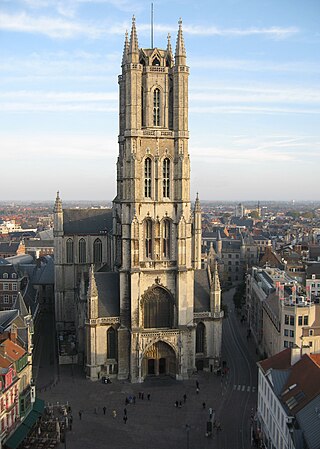
Saint Bavo's Cathedral, also known as Sint-Baafs Cathedral, is a cathedral of the Catholic Church in Ghent, Belgium. The 89-meter-tall Gothic building is the seat of the Diocese of Ghent and is named for Saint Bavo of Ghent. It contains the well-known Ghent Altarpiece.
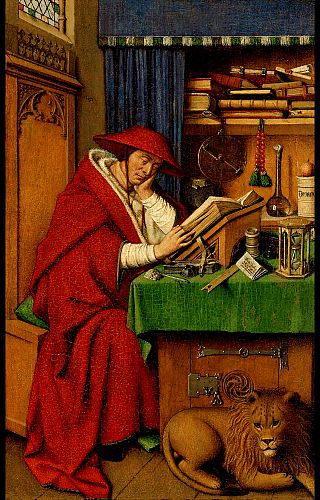
Saint Jerome in His Study is an oil painting on panel no larger than an oversized postcard attributed to the workshop of the early Netherlandish painter Jan van Eyck and is currently in the collection of the Detroit Institute of Arts. Purchased in 1925 by museum director Dr. W.R. Valentiner, the small Flemish painting at that time was attributed to Petrus Christus. The painting depicts St. Jerome, the 4th-century translator of the Bible, reading in his study, wearing a cardinal's dress and hat. He is surrounded by objects exemplyfying late medieval intellectual life and accompanied by the pet lion that is his common attribute.
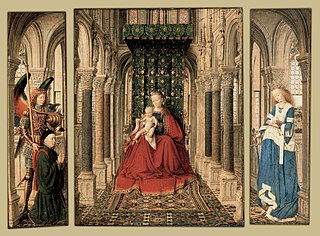
The Dresden Triptych is a very small hinged-triptych altarpiece by the Early Netherlandish painter Jan van Eyck. It consists of five individual panel paintings: a central inner panel, and two double-sided wings. It is signed and dated 1437, and in a permanent collection of the Gemäldegalerie Alte Meister, Dresden, with the panels still in their original frames. The only extant triptych attributed to van Eyck, and the only non-portrait signed with his personal motto, ALC IXH XAN, the triptych can be placed at the midpoint of his known works. It echoes a number of the motifs of his earlier works while marking an advancement in his ability in handling depth of space, and establishes iconographic elements of Marian portraiture that were to become widespread by the latter half of the 15th century. Elisabeth Dhanens describes it as "the most charming, delicate and appealing work by Jan van Eyck that has survived".

The Virgin and Child with Canon van der Paele is a large oil-on-oak panel painting completed around 1434–1436 by the Early Netherlandish painter Jan van Eyck. It shows the painting's donor, Joris van der Paele, within an apparition of saints. The Virgin Mary is enthroned at the centre of the semicircular space, which most likely represents a church interior, with the Christ Child on her lap. St. Donatian stands to her right, Saint George—the donor's name saint—to her left. The panel was commissioned by van der Paele as an altarpiece. He was then a wealthy clergyman from Bruges, but elderly and gravely ill, and intended the work as his memorial.
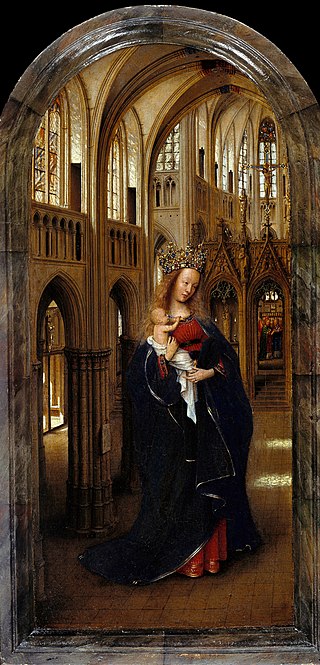
Madonna in the Church is a small oil panel by the early Netherlandish painter Jan van Eyck. Probably executed between c. 1438–1440, it depicts the Virgin Mary holding the Child Jesus in a Gothic cathedral. Mary is presented as Queen of Heaven wearing a jewel-studded crown, cradling a playful child Christ who gazes at her and grips the neckline of her red dress in a manner that recalls the 13th-century Byzantine tradition of the Eleusa icon. Tracery in the arch at the rear of the nave contains wooden carvings depicting episodes from Mary's life, while a faux bois sculpture in a niche shows her holding the child in a similar pose. Erwin Panofsky sees the painting composed as if the main figures in the panel are intended to be the sculptures come to life. In a doorway to the right, two angels sing psalms from a hymn book. Like other Byzantine depictions of the Madonna, van Eyck depicts a monumental Mary, unrealistically large compared to her surroundings. The panel contains closely observed beams of light flooding through the cathedral's windows. It illuminates the interior before culminating in two pools on the floor. The light has symbolic significance, alluding simultaneously to Mary's virginal purity and God's ethereal presence.
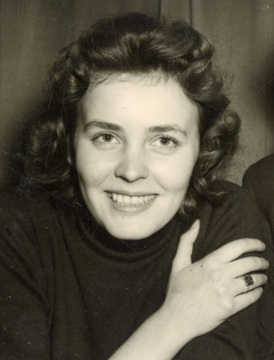
Princess Christina Margarethe of Hesse was a German princess. A first cousin of King Charles III of the United Kingdom, she was the wife, from 1956 to 1962, of Prince Andrew of Yugoslavia, a son of Alexander I of Yugoslavia.

Saint Francis of Assisi Receiving the Stigmata is the name given to two unsigned paintings completed around 1428–1432 that art historians usually attribute to the Flemish artist Jan van Eyck. The panels are nearly identical, apart from a considerable difference in size. Both are small paintings: the larger measures 29.3 cm x 33.4 cm and is in the Sabauda Gallery in Turin, Italy; the smaller panel is 12.7 cm x 14.6 cm and in the Philadelphia Museum of Art. The earliest documentary evidence is in the 1470 inventory of Anselm Adornes of Bruges's will; he may have owned both panels.
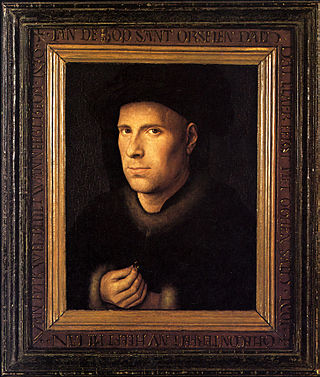
Portrait of Jan de Leeuw is a small 1436 oil on wood painting by the Early Netherlandish master Jan van Eyck, now in the Kunsthistorisches Museum, Vienna. De Leeuw was a goldsmith living in Bruges; most art historians accept that, given the familiarity of the portrait, that he and van Eyck knew each other and were on good terms. The work is still in its original frame, which is painted over to look like bronze.

The Mystic Marriage of St. Catherine is a c. 1480 oil-on-oak painting by the Early Netherlandish painter Hans Memling, now in the Metropolitan Museum of Art, New York. The Virgin Mary sits on a throne in a garden holding the Child Jesus in her lap. Mother and child are flanked by angels playing musical instruments, with St Catherine of Alexandria to the left opposite St Barbara on the right. The male figure standing slightly behind the celestial group presumably commissioned the painting as a devotional donor portrait.

The Pagagnotti Triptych is an oil-on-wood triptych by Hans Memling produced circa 1480. The original was disassembled and separated, with the center panel held at the Uffizi gallery in Florence and the two wing panels at the National Gallery in London.